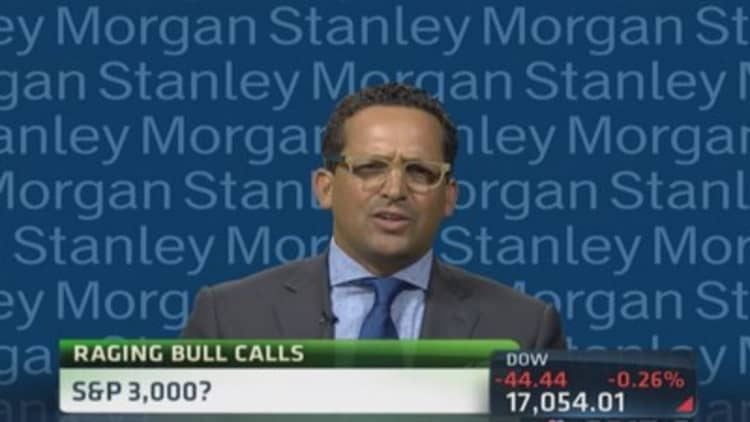
Forget S&P 2,000.
There's a slow and steady path for the stock index to hit 3,000, Adam Parker said Tuesday.
Morgan Stanley's chief U.S. equity strategist said that two things make him a believer: Hubris and debt.
"If you don't see a lot of hubris and you don't see a lot of debt, it's hard to call that top of the cycle," he said on CNBC's "Halftime Report."
Read MoreJPMorgan bets big on US recovery
Parker said his team looked at such measures as capital spending, hiring, inventory, debt and interest coverage.
"If you look at those issues, I think there's a lot of evidence that this could be a pretty prolonged expansion," he said. "And if you just think that through, if you get kind of mid-single-digit growth every year for the next several years, you can start getting a lot higher on the S&P."
Parker said that the U.S. expansion, now in its fifth year, could continue for another five years, hitting his 2020 target of 3,000 for the S&P 500.
"Look, you always, always sound smarter when you're a bear than when you're a bull. No doubt about that, and the world is a risky place," he said, noting that threats to the rally could come from Europe or maybe from China. "We're not saying it's a slam-dunk. We're just saying look at how uncorrelated the GDPs are around the world. Look at the debt stack and the interest coverage on it. Look at where costs are being put in place."
Margin expansion could also push stock prices higher, Parker added.
Read MoreWhy this bull market has room to run: Jeremy Siegel
"The mega-cap companies seem to have done stuff that's structural in terms of margin improvement," he said. "And I don't know if everyone knows this, but small-cap margins today in the U.S. are only at their long-term average. So, in a slowly improving economy, that means a lot of companies that continue to improve."
Parker also said that he still liked small-cap stocks, even at their current valuation levels.
"I think there are three positives, one negative," he said. "The three positives are: Faster growth, more margin-expansion potential and they generally benefit as M&A picks up. I think the negative is people think they're more expensive."
The Federal Reserve's tapering of its bond purchases, Parker added, wouldn't necessarily hurt his thesis.
Read More4 stocks to buy at all-time highs: 'Fast Money' pros
"I think historically, by the way, when the Fed raises the front end, the stock market usually goes up because usually there's growth that's strong enough to offset it," he said. "Our house call is growth's going to remain pretty muted, and so the Fed won't act even until 2016. So, we think we get a slow, steady, long cycle, not one that rockets up."
—By CNBC's Bruno J. Navarro


